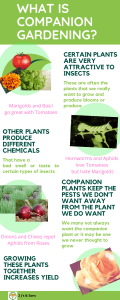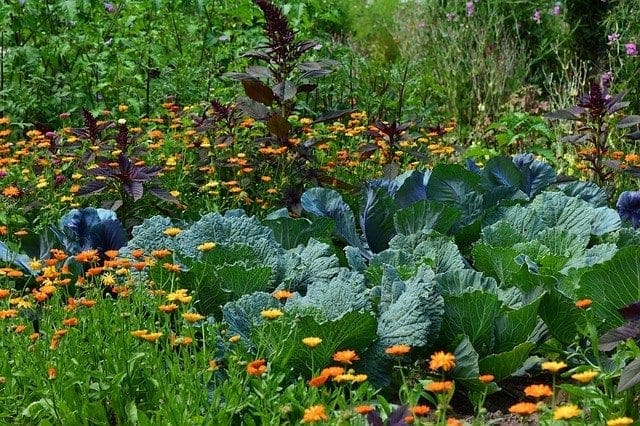
We started learning about and using companion gardening about seven years ago. It is a very easy, time-saving, and cost-effective method to keep your garden happy and cut out a lot of chemicals. There are a lot of great books and the internet is full of resources about the practice. I wish we had started doing it sooner.
What is Companion Gardening
To break it down companion gardening is simply growing plants that are beneficial to each other in the same location. In some cases, one plant may repel a pest that commonly affects another plant, or a certain plant may grow deeper roots and deposit nutrients and minerals that another plant needs. Some vegetables or herbs may even make others taste better or increase yield. This is the way our grandparents did it, and now it is nearly a lost art. Lucky for us thanks to the trendy new green movement this practice is making a come.
Planting tomatoes and basil near each other is a good example of companion gardening. The basil’s strong smell repels unwanted insects from the tomatoes, and in return, the tomatoes provide shade for the basil as they mature. Some people also believe that basil makes their tomatoes taste better (it kind of makes sense I add basil to almost everything I cook with tomatoes).
On the other hand, it is important to realize that not all plants should be grown near each other. We learned this the hard way in our home vegetable garden. One year we ended up with spicy banana peppers because we planted them too close to jalapenos. The nearby bell peppers suffered the same fate and the jalapenos came out sweet. Cross-pollination is in the works, but lesson learned and we won’t be doing that again.
Visual Appeal Of Companion Gardening
Marigolds and other flowers provide benefits as much as veggies and other herbs do. Incorporating flower borders around your vegetable garden is a great idea. This concept adds a lot of appeals and turns an otherwise visually boring vegetable garden into a landscaping masterpiece. Most visitors will never know how hard those gorgeous marigolds or nasturtiums are working to protect your crop from aphids and other pests.
I love companion gardening it costs less and helps make my garden be more self-sustaining, which saves us time and worry. We have fewer little critters eating our valuable produce before we can get to it. I don’t have to worry about my chickens getting into all of those chemicals that would otherwise inevitably wash out into my whole yard. Top that off with giving my whole yard a cozy cottage appeal, and giving the birds and butterflies more reason to stay.
Here are some of the combinations we use in our garden. There are many more and to be honest, I can’t remember a lot of them or the exact reason why we plant things where we do anymore it just works and we haven’t had hornworms in our tomatoes for years.
Companion Gardening Combinations
- Tomatoes by Basil and marigolds
- Beans go with just about anything
- Mint deters mice and aphids we plant it all over (be careful it spreads fast)

mint - Broccoli by Oregano
- Bell Peppers by Tomatoes
- Sage goes well with Broccoli and Cauliflower plus the bees love when it blooms
- Strawberries and Thyme go well together if you have a worm problem
- Hot Peppers nowhere near the Sweet Peppers
- Catnip and eggplant to deter flea beetles
- Cucumbers and radishes
- Cilantro and spinach
- Garlic and roses help keep Japanese beetles away
- Positive little critters that will prey on the more destructive ones
- Yarrow brings in bees
- Camille bring in wasps
- Angelica attracts lady beetles and lacewings


